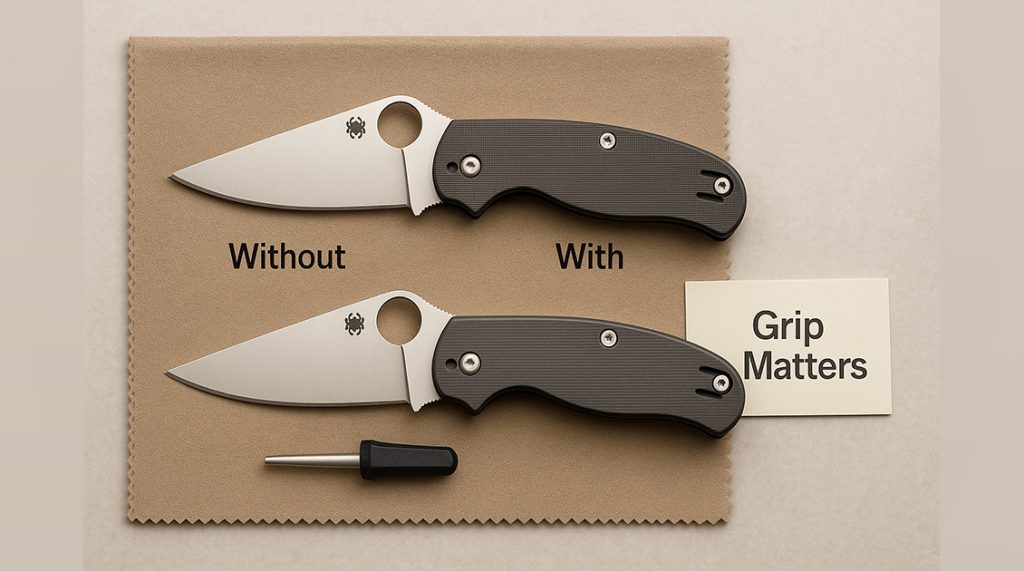Adding Jimping to Your Spyderco: Does It Really Improve Grip?

This is the 42th blog of the Spyderco blog series. You can check the other blogs I wrote from here – https://spydercoparts.com/blogs
Author: Logan M. Fraser
Occupation: Custom Knife Modder & Spyderco Parts Specialist
Location: Calgary, Alberta, Canada
Adding jimping to a Spyderco knife is one of the most debated modifications in the community. The main keyword here is Spyderco jimping, and many owners wonder if it really improves grip, comfort, and control—or if it’s just cosmetic. As someone who has customized hundreds of Spydercos, I’ll break down what jimping does, how to add it properly, and whether it’s worth the effort.
What Is Jimping and Why Does It Matter? 
Jimping refers to small notches or grooves cut into the spine of a knife blade, handle, or backspacer. These ridges create additional traction for your thumb or index finger during use. Spyderco already integrates functional jimping in models like the Para 3 and Manix 2, but some knives come with smoother spines where modders add aftermarket jimping.
Benefits of well-done jimping:
-
Better thumb purchase when applying pressure
-
More control in precision cuts
-
Extra safety for push cuts or detail work
Drawbacks of poorly done jimping:
-
Can feel too aggressive, causing hot spots
-
Risk of over-cutting into the blade spine
-
Potential to void warranties if not done correctly
Factory vs. Aftermarket Jimping 
Spyderco’s factory jimping is typically laser-cut and well-positioned for ergonomics. However, some users feel it’s either too shallow or absent on certain models. That’s where aftermarket jimping mods come in.
Factory Jimping Examples:
-
Spyderco Para Military 2 (excellent thumb ramp traction)
-
Manix 2 (spine and choil jimping for dual grip)
Aftermarket Jimping Uses:
-
Adding grip to smoother models like the Endura or Sage series
-
Customizing aesthetics for a more aggressive look
-
Pairing with aftermarket scales or backspacers for improved handling
If you want consistency, stick to factory jimping. If you enjoy customization, aftermarket jimping can make your knife feel more “yours.”
How to Add Jimping Safely 
Here’s my step-by-step process when I add jimping to a customer’s Spyderco:
-
Mark the Spine: Use a fine-tip marker to outline where the jimping should sit.
-
Secure the Blade: Clamp the knife spine safely in a padded vise to prevent scratches.
-
Cut the Jimping: Use a round file, triangle file, or Dremel tool with a steady hand. Go slow—removing too much steel weakens the blade.
-
Check Comfort: After a few grooves, run your thumb across. Adjust the depth until it feels secure but not sharp.
-
Finish & Polish: Smooth the edges with 600+ grit sandpaper or a buffing wheel to avoid sharp burrs.

Tools & Parts I Recommend 
-
Diamond files or quality needle files
-
Dremel with cutting discs and polishing wheels
-
Masking tape to protect the blade
-
Replacement scales and backspacers for pairing mods (available here)
-
Good lighting and a padded workbench
Does Jimping Really Improve Grip? 
From my personal experience, yes—when done correctly. A well-placed jimping notch makes a huge difference for control during precise cuts and heavy push work. However, it’s not always necessary. For example:
-
If you use your Spyderco mostly for light EDC tasks (opening packages, food prep), factory grip is usually enough.
-
If you rely on your knife for outdoor use, bushcraft, or tactical applications, aftermarket jimping can be a game-changer.
The real improvement comes when jimping complements ergonomics rather than overwhelms them.
Alternatives to Adding Jimping 
If you’re unsure about cutting grooves into your blade, there are other mods that can also improve grip:
-
Textured Scales: G10 or Micarta scales with custom patterns provide excellent traction.
-
Backspacer Upgrades: Adding a grippy backspacer can anchor your grip without altering the blade.
-
Grip Tape Mods: A simple, non-permanent solution for more friction.
These alternatives are reversible, unlike permanent jimping cuts.
Reliable Sources & Community Opinions 
Many knife enthusiasts debate jimping in forums like BladeForums and Spyderco’s official forum. These communities are excellent resources for gathering opinions before committing to permanent mods.
For technical discussions on knife ergonomics, you might also find articles on Knife Informer valuable.
Wrapping It Up: My Take
So, does adding jimping to your Spyderco really improve grip? 
My advice: start with reversible mods like scales or backspacers. If you find you still need more traction, then consider permanent jimping—and take it slow.
This is part of my ongoing Spyderco blog series where I share modding insights, techniques, and trusted parts that I use every day in my shop.
Check out more posts here: https://spydercoparts.com/blogs for deep dives into lock tuning, pivot upgrades, blade alignment, and more.
Got a question about jimping or grip mods? Drop it in the comments below—I answer every one. And tell me what you’d like to see next week: sharpening tricks, aftermarket clips, or even spine refinishing?


